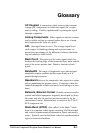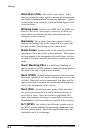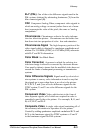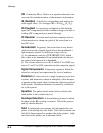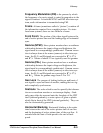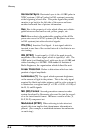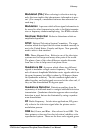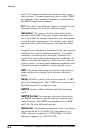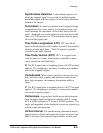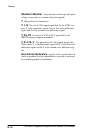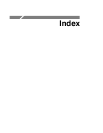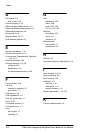
Glossary
1760 Series Component Waveform/Vector Monitor User Manual
G-7
Modulated (PAL) When referring to television test sig-
nals, this term implies that chrominance information is pres-
ent. (For example, a modulated staircase has subcarrier on
each step.)
Modulation A process which allows signal information to
be moved to other frequencies in order to facilitate transmis-
sion or frequency-domain multiplexing. See FM for details.
Nonlinear Distortion Refers to distortions which are
amplitude-dependent.
NTSC National Television System Committee. The orga-
nization which developed the television standard currently in
use in the United States, Canada, and Japan. Now generally
used to refer to that standard.
PAL Phase Alternate Line. Refers to one of the television
systems used in Europe and many other parts of the world.
The phase of one of the color difference signals alternates
from line to line to help cancel out phase errors.
Quadrature AM A process which allows two different
signals to modulate a single carrier frequency. The two sig-
nals of interest Amplitude Modulate carrier signals which are
the same frequency but differ in phase by 90 degrees (hence
the Quadrature notation). The two resultant signals can be
added together, and both signals recovered at the othe r end, if
they are also demodulated 90 degree s apart.
Quadrature Distortion Distortion resulting from the
asymmetry of sidebands used in vestigial sideband television
transmission. Quadrature distortion appears when envelope
detection is used, but can be eliminated by using a synchro-
nous demodulator.
RF Radio Frequency. In televi sion applications, RF gener-
ally refers to the television signal after the picture carrier
modulation process.
RGB Red, Green, and Blue. Also referred to as GBR. The
three primary colors used in color television’s additive color
reproduction system. These are the three color signals gener-





